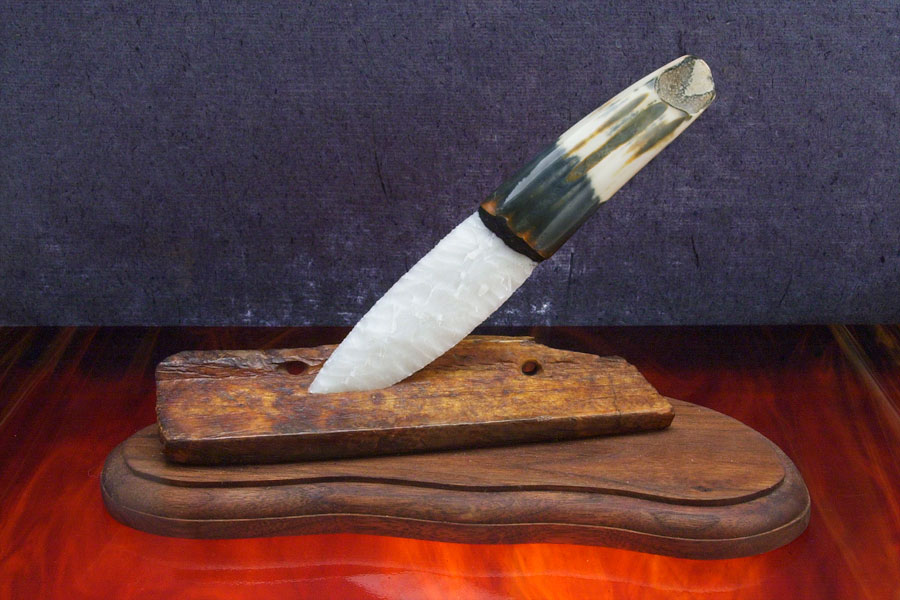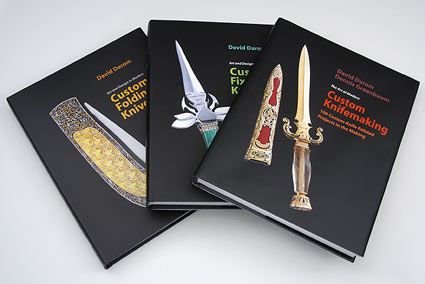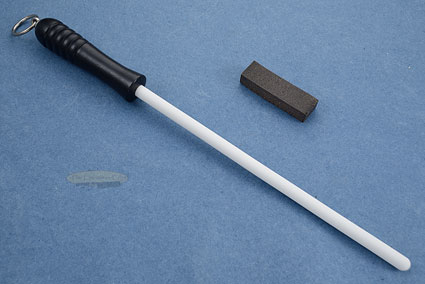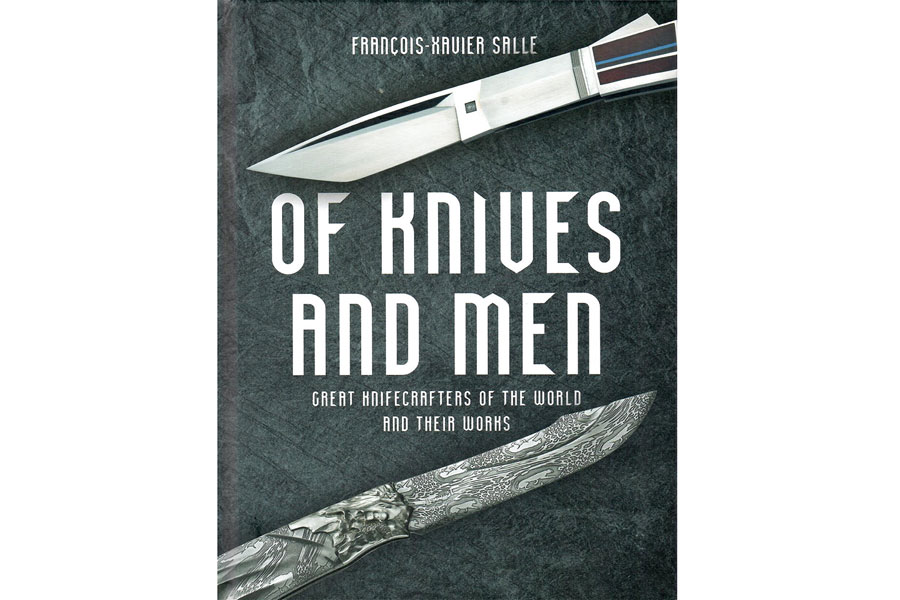User Login
ARTISAN MADE
OTHER PRODUCTS
KNIFEMAKING SUPPLIES
STAFF PICKS & GIFT IDEAS
SERVICES
INFORMATION
-
Welcome, Guest
- ( My Account | View Cart | Login )
ARTISAN MADE
OTHER PRODUCTS
KNIFEMAKING SUPPLIES
STAFF PICKS & GIFT IDEAS
SERVICES
INFORMATION
Featured Products
Three Books by Dr. David Darom: Art and Design in Modern Custom Fixed-Blade Knives, Art and Design in Modern Custom Folding Knives, and The Art of Custom Knifemaking
Of Knives And Men - Great Knifecrafters Of The World And Their Works by Francois-Xavier Salle
Sled Runner
Washington knifemaker Webb Hammond creates flint knapped knives that are true museum quality. This stunning display combines a sled runner artifact with Webb's expertly knapped custom knife. This knife was kept in a private collection since it was made. It is in brand new condition and by all appearances, Webb could have made it yesterday.
The white flint blade is hand knapped to a sharp edge. Webb used a traditional technique to hold the blade in place - black pitch. The handle ancient walrus ivory that is between 6000 and 9000 years old. Deep colors have leached into the ivory from surrounding soil over the centuries.
The knife is accompanied by a presentation stand. During the early to mid 1800s, Yupic Eskimos used ancient walrus ivory for a wide range of tools including fire starters, fishing weights, halibut hooks, and sled runners. A section of artifact Yupic sled runner is set on a wood base. Mounting holes and general shape from its former purpose as a sled runner are intact.
Exceptional work throughout!
Renaissance Wax (200ml)
Renaissance Wax is the #1 choice of major museums and art galleries for the preservation of the precious pieces.
Renaissance Wax is a revolutionary formula that is a semi-synthetic micro-crystalline fossil-origin wax entirely free of, damaging acids. It remains chemically neutral and is therefore completely safe, even on vulnerable surfaces.
Guard your precious pieces against the damaging effects of humidity, heat, dust, environmental destruction, aging, and ordinary wear. Renaissance Wax provides a barrier against fingerprints and the devastation of water, wine, alcohol and other spills. With its high moisture resistance, it forms a durable, lustrous protective coating. Prevents tarnish, corrosion and "bloom". Remains completely waterproof.
Three Books by Dr. David Darom: Art and Design in Modern Custom Fixed-Blade Knives, Art and Design in Modern Custom Folding Knives, and The Art of Custom Knifemaking
Special Price!! Both of Dr. David Darom's books sold together! Full retail price of both books: $255 (33% discount)
Art and Design in Modern Custom Folding Knives
Art and Design in Modern Custom Fixed-Blade Knives
The Art of Custom Knifemaking: 100 Custom Knife Related Projects in the Making
These books are unique among books about custom knives. They provide unparalleled photography and information about some of the best knife makers in the world.
These books provides insight into the personal lives of the artists as well as their thoughts and feelings about their craft -- breathing life into steel objects. This was achieved only by the full and enthusiastic cooperation of everyone involved, presented here in the form of their biographies and signed personal statements.
To complete the documentation of this astounding modern art form, a group of world experts wrote an original introduction to the books.
Flitz Metal Polish (150g)
Flitz is an excellent metal polish for carbon steel knives as well as fiberglass. This anti-tarnish formula lasts up to 6 months. It is non-abrasive, non-toxic, non-flammable, acid-free, won't dry out, and leaves behind no residue. Not designed for Damascus steel.
$22.95 DetailsJapanese Straight Razor (Wa-kamisori)
The Wa-kamisori, Japanese straight razor, is a perfect example of the Japanese aesthetic. This razor was produced in the workshop of bladesmith Shigeyoshi Iwasaki (b. 1933), in cooperation with his apprentice Ryoichi Mizuochi. Shigeyoshi-san is the son of renowned metallurgist and sword researcher, Hiroshi Iwasaki, who is well respected as a leading authority on traditional forging techniques. Shigeyoshi Iwasaki is considered by many to be the greatest straight razor maker of all time. His work is quite simply beyond compare.
Made of the finest carbon steel and fire-forged with Rentetsu iron (wrought iron), the blade is polished with natural sharpening stones. The blade bear's Iwasake's mark on the back of the blade.
These razors are a source of great pleasure for collectors and users alike. Delivered in a beautiful kiri-wood case.
Rust Eraser (Sabitoru), Fine (320 grit)
This Rust Eraser nicely cleans and buffs away scratches & light surface rust on metal surfaces and more. 320 grit abrasive is suspended in a slightly "springy" rubber matrix, making it perfect for cleaning up slight imperfections on both curved and flat surfaces. The 320 grit Rust Eraser is very quick to remove rust and scratches and provides a clean looking satin finish. To clean up a surface faster, either start at the 46 grit Rust Eraser or the 120 grit Rust Eraser.. Measures approx. 2 3/4 inches x 1 1/2 inches x 1/3 inch.
Made in Japan.
Camellia Oil, 60ml (2 oz)
For centuries, camellia oil has been used to protect the finest Samurai swords. A small amount applied to your carbon steel knives will keep them free of corrosion and rust. Camellia oil is non-toxic and non-allergenic.
This spray bottle is a great size for professional chefs who want a bottle to carry in the knife bag.
Chef Steps Ceramic Rod and Cleaner
This set has everything you need to properly take care of your knives.
Ceramic rods provide the best touch up possible between sharpening. By removing very little material, the blade is honed to a razor edge. Fine ceramic rods will hone a knife to the most optimal edge. However, if a considerable time has passed since honing or sharpening, a coarse rod is often required. Generally, a ceramic rod should be approximately the length of the longest knife that you will be honing. This set comes with a 12 inch fine ceramic rod.
Over time, ceramic rods build up metal particles that clog the abrasive surface. The Superaser cleans the surface of all ceramic rods so that they will continue to hone just like they did when they were new.
Nano-Oil (10W8CC)
Nano Oil is our favorite lubricant for folder mechanisms. The 10 weight oil ensures smooth action instantly.
At under .090 micron in size, the active molecules of Nano-Oil are called Nano Bearings. They truly are within the nano scale technology. They are magnetically induced to adhere to microscopic crevices and actually penetrate metals, providing a very low friction, dynamic contact.
NanoLube formulations are compatible with most existing lubricants on the market today - both synthetic & mineral. The Nano-Bearings concentration level is such that adding a few drops to a common lubricant will dramatically improve its anti friction qualities.
The convenient needle applicator makes is easy to apply oil exactly where it is needed!
How To Make A Narrow Tang Knife
Beginning with making, heat treating, and sharpening a stock removal knife and moving into forging, forming the handle, and sewing the sheath, this exceptional manual is sure to help avoid many of the pitfalls that many knifemakers encounter as they begin their path. Even experienced knifemakers are sure to find different techniques that will improve their process and provide new approaches. How to Make a Narrow Tang Knife is sure to become a daily companion.
This book is signed by Kevin and Heather Harvey.
Mastersmiths Kevin and Heather Harvey have had a tremendous influence of forged South African custom knives. When I first met them in 1998 at the ABS Bladesmithing School in Old Washington, AR, it was clear that they arrived with exceptional talent and drive. What wasn't yet apparent was the number of bladesmiths that they would educate and inspire over the years to come. Rather than just returning to South Africa after our courses at the ABS school and proceeding to make their knives, they were immediately inspired to share the knowledge they gained.
They soon founded Heavin Forge and have taught countless bladesmiths from all over the world their techniques for knifemaking. Their style and methods are found in nearly every bladesmith coming out of South Africa today. Their devotion to sharing their knowledge has created a boon for knifemakers in and around Southern Africa.
When COVID19 began to spread in the spring of 2019, Heavin Forge needed to pivot. Their intimate classes would not be viable for several years to come. During this time, rather than simply ruminating, Kevin and Heather worked together to write and create this how-to manual. The photos and exceptionally detailed descriptions walk the reader through every step of making a knife. Having instructed thousands of students over 25 years at Heavin Forge and teaching at the ABS School, Mastersmiths Kevin and Heather understand the problems that beginning bladesmiths will encounter. This manual nicely catches those mistakes and explains each step in an easy-to-follow format.
- Publisher: Heavin Forge Media (July 13, 2022)
- Language: English
- Paperback: 272 pages
- ISBN-10: 0639714382
- ISBN-13: 978-0639714387
- Dimensions: 8.5 x 0.71 x 11 inches
Of Knives And Men - Great Knifecrafters Of The World And Their Works by Francois-Xavier Salle
Of Knives and Men is a superb display of the world's foremost contemporary knifecrafters.
The 46 artisans and their works selected for this book are the most representative of the last 30 years. Each has their own style and character, mixed with utility and the knifemaking tradition of their home country and culture. Others are quite startling in their inventiveness: a simple steel knife with a handle made from a fox's lower jaw (Mickaël Moing, France); damascus steel blade and an ancient mammoth ivory handle (Pekka Tuominen, Finland); stainless steel blade with an ironwood handle encrusted with mother of pearl and precious stones (Harumi Hirayama, Japan); and a "button lock" knife of damascus steel, with a handle of damascus, gold, titanium and mother of pearl (Michael Walker, USA).
The knifemakers are from many countries -- Brazil, USA, France, Slovakia, Finland, Japan, Italy, Canada, South Africa and more -- displaying a stunning variety of materials and techniques.
There are 217 astounding knives and sheaths in all, plus a directory of decorative materials used for the handles and sheaths -- from birds eye maple to mammoth molar, carbon fiber and fossilized coral -- and techniques from ancient and lost-and-then-rediscovered to space age. All have a grade of cost and contact information for the makers. Extra sections on embellishments like scrimshaw, engraving and sculpting of handle material are added.
This is a unique and beautiful volume that will have very wide appeal.
- Publisher: Firefly Books (September 30, 2022)
- Language: English
- Hardcover: 240 pages
- ISBN-10: 0228104009
- ISBN-13: 978-0228104001
- Dimensions: 8.25 x 0.56 x 11 inches















